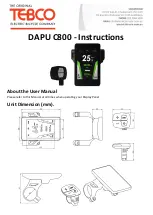
EN
29
axle, otherwise the bearings in the wheel
axle can gradually become damaged.
SADDLE AND SADDLE POST
Grease the saddle post and insert it into the
saddle tube, and then lock to the required
height with the quick-release.
IMPORTANT:
The marking for the top position on the
saddle post should not be seen over the
saddle tube.
PEDALS
The pedals are different and are therefore
marked with "L" (Left) and "R" (Right). If they
are fitted on the wrong side or screwed in skew
in the crank arms this can damage the threads.
Grease the threads on the pedals before fitting.
FIG. 5
Fitting the right-hand pedal (R)
Screw in the pedal
clockwise
on the chain side
of the crank arm and tighten with a 15 mm
combination spanner.
FIG. 6
Fitting the left-hand pedal (L)
Screw in the pedal
anticlockwise
, on the
opposite side of the chain, and tighten with a
15 mm combination spanner.
FIG. 7
USE
SITTING POSITION
It is important that the bike is correctly adjusted,
so that it is both comfortable and safe.
FIG. 8
HANDLEBARS
1. Unscrew the bracket (1) on the stem with
a 5 mm hex key.
FIG. 2
2. Put the handlebars on the stem. Make
sure that they are properly centred and
have a suitable angle for the handbrake
and gear lever, and that the brake and
gear wires are on the right sides of the
frame and front fork. If the wires are not
properly positioned the handlebars or
fork has turned, and must be turned back
before fitting the handlebars.
3. Screw together the bracket and tighten
the two hex screws alternately.
It is also possible to change the position of the
handlebars by angling the stem. Undo the hex
screw (2), angle the stem and firmly tighten the
screw. The handlebars may need to be adjusted
as per point two above, to achieve a suitable
angle for the handbrake and gear levers.
FRONT WHEEL
1. Press the front brake together and unhook
the brake wire so that the brake separates.
FIG. 3
2. Hook the front wheel in the front fork, with
the tyre in the correct direction of rotation.
3. Make sure that the front wheel is centred
between the fork legs.
4. Close the quick-release lock and firmly
tighten the adjusting nut on the opposite
side. Open the quick-release lock, tighten
the adjusting nut another 3/4 turn, and
then close it again. Closing the quick-release
takes a little effort, so that it does not open
unintentionally and loosen the wheel.
FIG. 4
(the bike shown is from another model)
NOTE:
It is very important that the springs are
positioned on each side of the quick-release
Summary of Contents for 006377
Page 3: ...1 2 19 18 17 16 15 14 12 11 10 9 8 7 6 5 4 3 2 1 13 2 1 ...
Page 4: ...5 3 4 ...
Page 5: ...7 8 6 ...
Page 6: ...10 11 12 9 ...
Page 7: ...15 14 1 2 3 4 5 6 7 8 13 ...
















































